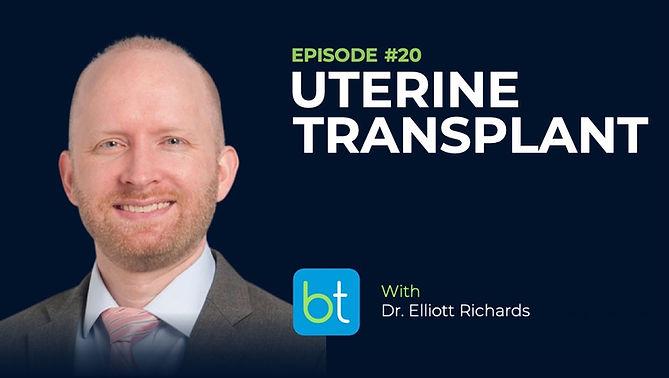BackTable / OBGYN / Podcast / Episode #20
Uterine Transplant
with Dr. Elliott Richards
In this episode, Dr. Elliot Richards, a true physician-scientist and Director of Research in the Department of Reproductive Endocrinology and Infertility at the Cleveland Clinic, shares about his experience and studies regarding uterine transplant.
Be part of the conversation. Put your sponsored messaging on this episode. Learn how.

BackTable, LLC (Producer). (2023, April 6). Ep. 20 – Uterine Transplant [Audio podcast]. Retrieved from https://www.backtable.com
Stay Up To Date
Follow:
Subscribe:
Sign Up:
Podcast Contributors
Dr. Elliott Richards
Dr. Elliot Richards is the Director of Research in the Department of Reproductive Endocrinology and Infertility at the Cleveland Clinic.
Dr. Amy Park
Dr. Amy Park is the Section Head of Female Pelvic Medicine & Reconstructive Surgery at the Cleveland Clinic, and a co-host of the BackTable OBGYN Podcast.
Dr. Mark Hoffman
Dr. Mark Hoffman is a minimally invasive gynecologic surgeon at the University of Kentucky.
Synopsis
Dr. Richards describes uterine transplant in the modern era as truly “patient-driven” and due to “patient-demand.” He begins the episode by detailing the history of uterine transplant, which was initially attempted in the 1930s, even before the first successful renal transplant 20 years later. More recently, successful uterine transplants were first conducted in Saudi Arabia, Sweden, Turkey, and now in a few United States institutions (e.g. Cleveland Clinic, University of Alabama at Birmingham, University of Pennsylvania, and Baylor).
He then addresses arguments or concerns against uterine transplant. Ultimately, Dr. Richards encourages listeners to identify infertility as a disease and one that warrants treatment, prompting the use of uterine transplant.
The physicians then discuss the process of uterine transplant. In current trials, the majority of patients are people with a diagnosis of mullein agenesis. Dr. Richards highlights that this population does not reflect the actual population that suffers from absolute uterine factor infertility (AUFI) and that he hopes that access to the procedure will expand for a more diverse patient population. He then describes the types of uterine donors (e.g., directed donor, non-director donor, deceased donor model, etc.) that are utilized by different institutions; the surgical process of the transplant itself; immunosuppression and pregnancy; as well as fertilization via IVF.
The episode ends with Dr. Richards discussing success rates by citing his prior studies, which includes a 74% 1-year graft survival and 83% live birth rate among those with a viable graft at 1 year. Specifically within the Cleveland Clinic study population, one patient delivered the first second baby last September. Future directions regarding uterine transplant include better understanding the costs of the procedure, shortage of available donors, identifying the true demand, leveraging minimally invasive surgical techniques, and fallopian tube preservation.
Resources
“The Danish Girl” 2015 film directed by Tim Hooper
“Uterus Transplant Animation Recipient” by Cleveland Clinic - https://www.youtube.com/watch?v=13DwQ0HbuXc
“Cleveland Clinic Delivers Second Baby from Uterus Transplant” by Cleveland Clinic - https://www.youtube.com/watch?v=XJuedpL14AQ
Lefkowitz A, Edwards M, Balayla J. The Montreal Criteria for the Ethical Feasibility of Uterine Transplantation. Transpl Int. 2012 Apr;25(4):439-47.
Johannesson L, Richards E, Reddy V, Walter J, Olthoff K, Quintini C, Tzakis A, Latif N, Porrett P, O'Neill K, Testa G. The First 5 Years of Uterus Transplant in the US: A Report From the United States Uterus Transplant Consortium. JAMA Surg. 2022 Sep 1;157(9):790-797.
Transcript Preview
[Dr. Elliott Richards]
First of all, with a deceased donor, you can take the internal iliacs with the uterine artery vein, and so you're just getting much more wide excision than you can with a living donor obviously. There is potentially longer cold ischemia time with the deceased donor, especially if you're procuring. We've altered our radius a couple times in terms of procurement radius, how far out from our institution that we'll go. A further-out procurement means that you have longer cold ischemia time for that organ.
Although our data, especially as we've shared and compared with the Baylor group, we don't see any difference in outcomes. These are still small sample size number. I'd say the biggest disadvantage of using a deceased donor-- Well, there's three actually. One is that we really don't get as much history. We're relying on secondhand information in the medical record. Whether it's a living donor, you can get just such extensive information from that individual. The second thing is that there's really something to be said about a planned surgery. You can put on a date. You can assemble all the teams. Doing a uterus transplantation is an incredibly complex endeavor. Really, you need to have coordination between transplant teams. You have a procurement team, of course, and then you have the transplant team itself. The vaginal anastomosis and the vessel anastomosis, these are done by different teams. If you can do with the living donor and you can set everything up ahead of time, that has great advantages over a deceased donor where the call is always in the middle of the night and it's suddenly, everyone's canceling all their clinic. Transplant surgeons are used to that. Gynecologists, that's not really how we roll. The challenge is there.
Disclaimer: The Materials available on BackTable.com are for informational and educational purposes only and are not a substitute for the professional judgment of a healthcare professional in diagnosing and treating patients. The opinions expressed by participants of the BackTable Podcast belong solely to the participants, and do not necessarily reflect the views of BackTable.












